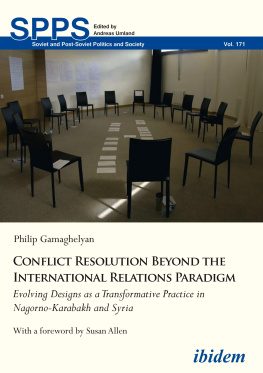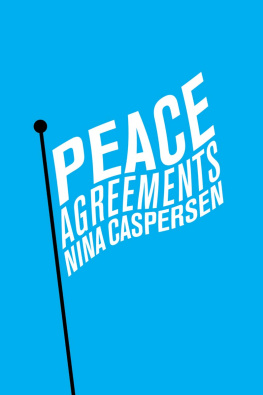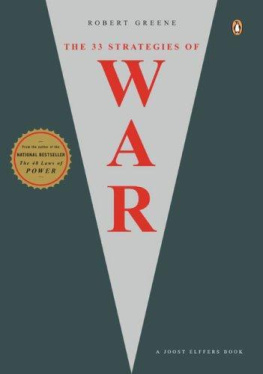Changing the Conversation
Changing the Conversation
THE 17 PRINCIPLES OF CONFLICT RESOLUTION
Dana Caspersen has a degree in conflict studies and mediation and works internationally as a mediator, teacher, and creator of public dialogue processes. She is an award-winning performing artist and has developed and performed choreographic work throughout the world. She lives in Germany and Vermont.
A Joost Elffers Book
Changing the Conversation
THE 17 PRINCIPLES OF CONFLICT RESOLUTION
Dana Caspersen

First published in Great Britain in 2015 by
PROFILE BOOKS LTD
3 Holford Yard
Bevin Way
London
WC1X 9HD
www.profilebooks.com
First published in the United States of America in 2015 by Penguin Books
Copyright Dana Caspersen and Joost Elffers, 2015
10 9 8 7 6 5 4 3 2 1
Set in Helvetica Neue LT Std
The moral right of the author has been asserted.
All rights reserved. Without limiting the rights under copyright reserved above, no part of this publication may be reproduced, stored or introduced into a retrieval system, or transmitted, in any form or by any means (electronic, mechanical, photocopying, recording or otherwise), without the prior written permission of both the copyright owner and the publisher of this book.
A CIP catalogue record for this book is available from the British Library.
eISBN 978 1 78282 1693
To my parents, with love and thanks for guiding me through many a tangle.
acknowledgments
Dana Caspersen
Thanks to everyone who has offered me their stories and helped me see possibility in conflict, to my teachers at the Woodbury Institute for their incisive, flexible wisdom, and to dancers everywhere for showing me what it means to carry out a daily practice of transformation, no matter what.
Special thanks to Joost Elffers for proposing this project and giving it form; to Carolyn Carlson, our wonderful editor at Penguin; and finally to my family, for everything.
Joost Elffers
Changing the Conversation is the result of a radical way of producing a book; there is no hierarchy in terms of content: concept, text, editing, and design are one. It is what I call a horizontal productionall aspects are equally important, and each part depends upon and is supported by the other.
I would like to express my thanks and appreciation to the following: Dana Caspersen for entrusting me with her writing and allowing me to visualize it; Molly Davies for introducing me to Dana; Carolyn Carlson, our editor at Penguin, for having the vision to see what this book would be. Special thanks go to Patricia Childers, an exceptional designer, who patiently and tirelessly helped me realize my design concepts for this book, and to Lindy Judge for her diligent editing and for keeping this project on track.
Conflict
You cant change how other people act in a conflict, and often you cant change your situation.
But you can change what you do.
By choosing the approaches discussed here, you can change your conversations.

| By changing your conversations, you can resolve conflict in your life. |
This book provides 17 principles for conflict resolution: practical tools for individuals in difficult situations.
see conflict as a moment of opportunity
The practice of these principles helps transform how conflict is expressed. It offers a way to resolve conflict from the inside, in a manner that works for everyone involved. The principles provide encouragement to see conflict as a moment of opportunity. They urge us to recognize that we have the ability to call up the curiosity and courage needed to step away from cycles of attack and counterattack and to move, instead, with as much grace and skill as we can muster, toward resolution.
Whether or not you read the chapters in this book sequentially, I recommend taking the time to do the exercises. The ability to engage conflict effectively is a matter of practice. Anyone who wants to develop this capacity can do so.
Conflict can be both useful and inevitable.
Destructive conflict is neither.
conflict
the anti-principles
resolution
the principles
facilitate listening and speaking
My great-aunt Marie taught me that when you are knitting and the strands of yarn get tangled, it is a mistake to try to undo the knot by seeking to free only one strand.
The strands of yarn are in a complex relationship to one another. Trying to solve the problem by extracting one strand will likely increase the complexity of the knot and make it more difficult to undo.
You need to understand the complex tangle of strands before you can discover a possible solution for undoing the knot.
At first, I tried the one-strand method anyway, thinking that if I got that strand free then the rest of the knot would dissolve. Instead, I watched the knot get tighter and more complicated and finally had to pull out the scissors. At some point, I grew tired of seeing that happen and tried the method my great-aunt proposed. I started looking at the whole knot to untangle the strands.
I began to try to discover why the knot was there.
In a conflict it can be tempting to try to undo the tangle before we have a sense of why it is there and what it is composed of. We may want to see ourselves as separate from what seems to be causing us trouble: what we dislike, disagree with, or dont understand. It can be tempting to believe that by removing ourselves from those unwanted people or situations, or removing them from us, we can solve the problem.
It rarely works that way, though. We need the other peoples stories to figure out what to do in a conflict. It doesnt matter whether we dislike them, distrust them, dont have faith in their reasoning capacity, or whether we love them. Their stories, in relationship to our story, tell us why the conflict is happening. The stories can help us understand what an effective solution might look like.
moving from certainty to inquiry
Find out what is going on.
Even when you think you already understand the situation, ask the others involved what is happening with them. This doesnt mean that you need to sit through a recital of what they think you did wrong. This means ask them to tell you what they have experienced in the situation, what is important to them, and why it is important. Then, as clearly as possible and without blame, do the same.
Of course, beginning or carrying on a productive conversation can sometimes seem impossible in a difficult conflict. We might be concerned that well make things worse, not know what to do, or lose ground. The temptation to avoid acknowledging the conflict or to continue open hostilities once they have begun can be strong. However, we are not doomed to endlessly repeat patterns that are destructive.
We have a choice. We can engage in conflict patterns that promote damaged relationships, violence, and lost op portunities, or we can set our minds to following a different path. With attention and practice, we can develop the ability and willingness to start those difficult conversations and be present with the tangled knot of conflict in an effective and beneficial way.
We can figure out what conflict has to tell us.
Seven questions to start the conversation
Begin with the willingness to hear the other persons story and to tell yours. Whether it is in a calm conversation or something that feels more like a fight, a first step is to take a breath and shift from battling about positions to talking about experience.
Next page










